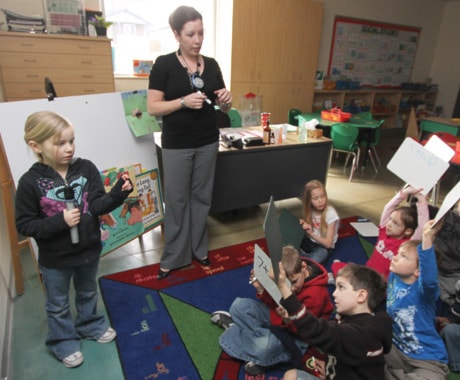By September, every kindergarten to Grade 3 student in the Red Deer Catholic Regional School Division will have sound amplification systems in their classrooms.
The sound systems involve teachers wearing microphones, with speakers on the four classroom walls that amplify their voices.
The idea is that if students — especially younger ones — hear better, they’ll learn better.
Research seems to back up the claim.
A study from 2005, suggests excessive noise in the classroom can affect children’s memory and affects their ability to pay attention in the classroom. The ability to focus on speech improves as a person ages throughout childhood, so young children need to be able to hear their teachers better to understand as well as an adolescent or an adult would, according to the study by John Bradley with the National Research Council Canada. Younger children don’t have as extensive a vocabulary and, as a result, have a harder time filling in the blanks of a conversation they can’t hear clearly, according to a 2007 New Brunswick study.
Sinead Lynch, a Grade 1 teacher at Our Lady of the Rosary School in Sylvan Lake, was involved in a pilot project with the Catholic division over the past few years to try out a variety of amplification systems with her class and she likes the system.
“You definitely have a much more increased attention with the kids,” Lynch said. “I can be anywhere in the classroom and they can hear me.”
It’s particularly useful for a generation of students who spend much of their time outside of the classroom playing Wii or PlayStation, or watching videos.
“Kids now are coming in (with) so much exposure to video games, TV and movies, things that are loud and have lots of special effects, so my voice doesn’t compete with that,” Lynch said. The amplification system not only amplifies her voice for the children, but also the SMART board and computer in her room.
The system also comes with a microphone that the students can use and Lynch has found that to be a motivator for her classroom.
“The hand-held mic is a huge novelty for the kids because anytime they want to do any talking, you’re asking them to come up and they can talk into the mic. You can really build that up and build that in and say, ‘Who am I going to talk to next.’ It’s just a way better sell.”
A 2007 study that looked at 60 classrooms in New Brunswick suggested the use of microphones in class can encourage shy or quiet children to talk and the sound system is particularly helpful for children with hearing and learning disabilities or who are learning English as a second language.
The system has been better for the students, but it has also been better for Lynch.
“It’s a huge saver on my voice,” she said. “I don’t find my voice to be nearly as tired at the end of the day.”
So far, the systems have been installed at Our Lady of the Rosary in Sylvan Lake and three schools in Red Deer, including St. Patrick’s, Camille J. Lerouge and Holy Family. The Red Deer Catholic Regional School Division hopes to have systems in all Catholic kindergarten to Grade 3 classrooms by September, with 87 units at a cost of around $1,200 per unit — or a little more than $100,000. The cost was covered by a technology grant from the provincial government.
Paul Mason, associate superintendent of personnel services/technology, said they’re finding from the research, as well as their own experiences with the sound amplification systems, that students are able to follow instruction much more closely, their attention spans are increasing and they’re able to focus more. “The opportunities for distraction are minimized and we’re just finding their time on task is increasing, which is obviously beneficial,” he said.
sobrien@www.reddeeradvocate.com
